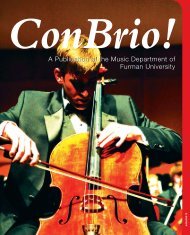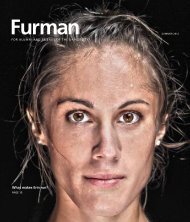Download - Furman University
Download - Furman University
Download - Furman University
- No tags were found...
Create successful ePaper yourself
Turn your PDF publications into a flip-book with our unique Google optimized e-Paper software.
Andrew Feight practices “rephotography,” recreating old photos to provide a visual record of change, as in this color photo of Bear Lake in Shawnee State Forest pairedwith one from 1936. Photo left courtesy The Ohio State <strong>University</strong>, Ohio Agricultural Research and Development Center, Wooster, Ohio. Forestry Images Collection.IllustratedHistoryMark Souther and Andrew Feightare using modern technology to buildthe historical record — and includethe public in the process.By Elizabeth CookeAndrew Feight ’93 stands on an earthendam overlooking Bear Lake, a small reservoirin southern Ohio’s Shawnee State Forest. Hecontemplates the stone inlet below, debatinghow best to approach it through the tangleof scrub and tall grasses.“Sometimes I think I need to bring amachete,” he says.He sports brown boots, khakis, a red feltvest and a baseball cap. A hefty camera hangsaround his neck. In one hand he holds a clipboard,in the other an iPhone equipped tocollect comprehensive geographic data. It’s justa typical day in the life of an atypical historian.Feight, a professor at Shawnee State <strong>University</strong>in Portsmouth, Ohio, has been exploring thehistory of the Scioto River Valley since he movedto the area in the early 2000s. He emphasizesthe importance of going into the field to talkwith people and to witness history firsthand.“You have to go to the historical sites to understandthem,” he says, because in doing so“you meet people who know more than you.”Feight also stresses the importance of preservinglocal history. “Part of my professionalresponsibility is to create a historical record,”he says. He does this by recording interviewswith longtime residents and by documentingsites through his photographs. “All history islocal,” he pronounces, and like any good historian,he cites his source: former CongressmanTip O’Neill of Massachusetts, who famouslymade the same claim about politics.Politics was on Feight’s mind when heenrolled at <strong>Furman</strong> in 1989 from Sandy Springs,Ga. At first he thought he would major in politicalscience and maybe go on to law school.Then he took a course with Lloyd Benson.“I really do credit Lloyd with clueing me in tothe possibilities of a career as a historian,” saysFeight, who soon changed his major to history.He was awarded a <strong>Furman</strong> Advantage Fellowship,and under the guidance of Benson spenta summer exploring the history of Greenvillethrough its architecture. He created two toursof the city’s architectural heritage that includedphotos and short descriptions of the featuredbuildings and explained how they fit into thebroader history of the South and the nation.With Benson’s help, Feight uploaded histours to a website. At the time, the Internetwas a relatively new development: “It was justsort of a storage place for the driving instructions,”says Benson. He and Feight could hardlyimagine that in less than two decades peoplewould be able to access this information froma device the size of their pockets.Today Feight is building a series of historicaltours about southern Ohio that cater to smartphones. To do it, he’s following the modeldeveloped by another <strong>Furman</strong> graduate fromthe early ‘90s.MARK SOUTHER ’94 was raised with a deepawareness of the past. A native of Gainesville,Ga., where his family has lived for many generations,Souther grew up within a few miles ofboth sets of his grandparents. They taught himabout their family and their hometown.“I had a big dose of history growing up asa kid,” says Souther. He and his parents andgrandparents often visited old home sites andthe family farm in the mountains, where heremembers digging up Cherokee Indian arrowheadsand pottery. “Things like that definitelymade the past come alive for me.”However, it wasn’t until Souther arrivedat <strong>Furman</strong> that he decided to pursue historyprofessionally. At that point, his story begins tosound familiar. “Honestly, more than anythingelse, taking Lloyd Benson’s classes really turnedme on to history,” says Souther. “WesternCiv — that’s the class that made me decideto major in history.”Despite their similar backstories, Feightand Souther were only casual friends at<strong>Furman</strong>. After graduation, each took hisown path toward becoming a historian.Feight spent his first post-<strong>Furman</strong> summerat the Atlanta History Museum where heinterned with Gordon Jones ’84, whose father,Ed Jones, was a longtime <strong>Furman</strong> historyprofessor. Feight assisted Gordon with researchfor a Civil War exhibit to be displayed duringthe 1996 Olympics. At the end of the summer,Feight went on to the <strong>University</strong> of Kentuckyto pursue graduate work in history.Souther also had a connection to the Jonesfamily. As a senior at <strong>Furman</strong> he took threecourses in Asian history, all taught by Ed Jones.“I still remember his slides from China,” saysSouther. “By that time, I was kind of a buddinggraduate student.” He followed his academicinclinations, attending the <strong>University</strong> of Richmondfor his master’s and Tulane <strong>University</strong>for his Ph.D.Feight and Souther first reconnected at ameeting of the American Historical AssociationChief Thunderwater of Cleveland, a strongadvocate for Native American causes.Photo from Western Reserve Historical SocietyLibrary Research Center.10 FURMAN | SPRING 2013FURMAN | SPRING 2013 11



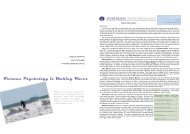
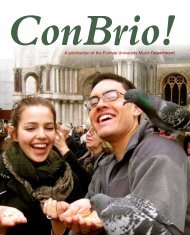
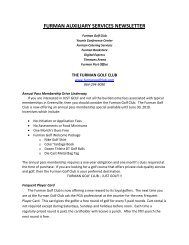
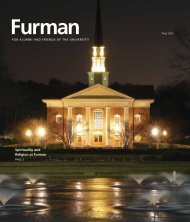

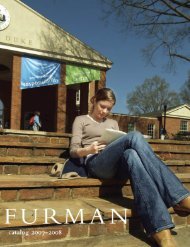
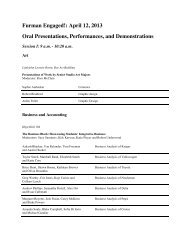

![Guidelines [PDF] - Furman University](https://img.yumpu.com/43814619/1/190x245/guidelines-pdf-furman-university.jpg?quality=85)
